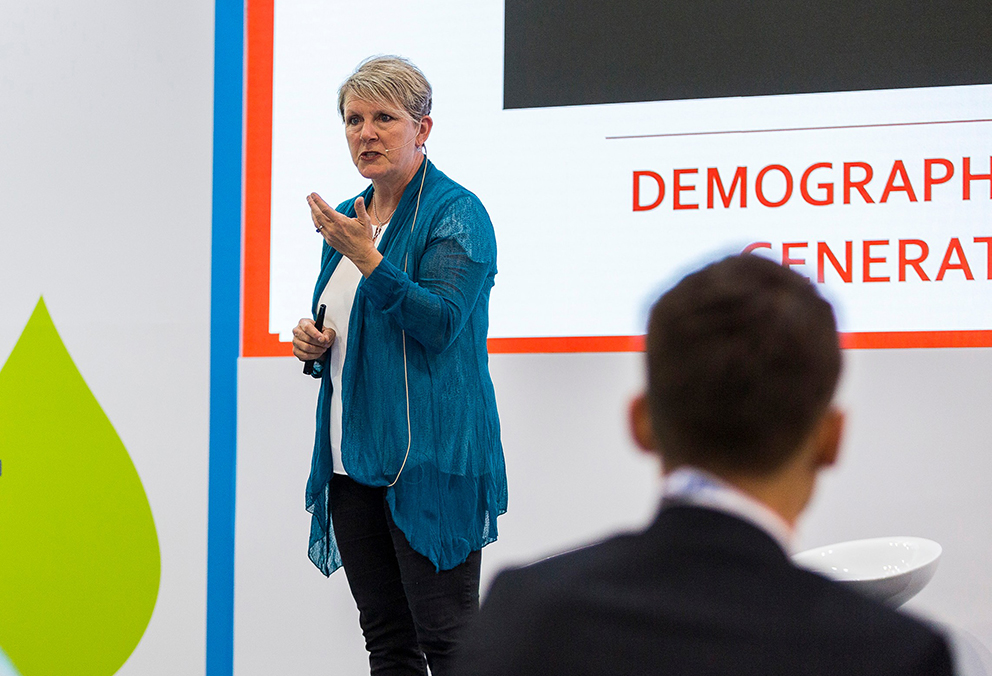Are you ready for Generation Voice?
Generation Voice will revolutionise digital retail. And it’s just one of various global macro trends set to shake up every fresh produce business. Lisa Cork, CEO of Fresh Produce Marketing Ltd, says we’re in a time of unprecedented disruption, but this brings opportunities for incredible differentiation. The way to survive and thrive is to understand what’s coming, she says. In a session on September 5 at Smart Horticulture Asia, part of the Asia Fruit Logistica show in Hong Kong, the New Zealand-based expert shared her advice on just how to do this.
The era of Voice activation
When she started out in fresh produce marketing over 25 years ago, Cork said there was one clear target to influence – the female household shopper. But fresh produce marketers today face a never before seen degree of demographic diversity. Now there are 6 main demographic groups to take into account – Silent, Boomers, Generation X, Millennials and Generation Z – plus the game-changing Generation Voice. The latter will be the generation that, from a very young age, verbalises commands into all sorts of audio devices, including phones and home speakers, and has the power of purchasing and influence in its hands from a far younger age than ever before. The fact that this generation will grow up with voice as its predominant interaction with technology
“changes everything about how we do everything,” Cork said.
Capitalise on increasing connectedness
The Internet of Things, or IoT, is all about connectedness. This trend has been driving us for the last decade and it’s only getting stronger.
“We are seeing a whole new way of connecting with the devices in our homes,” said Cork, who went on to share examples including the Samsung smart fridge.
Aptly called the Family Hub, this fridge allows people to manage their fresh food like never before, including to see inside it from anywhere with built-in cameras, create and share digital shopping lists, look up recipes on its touchscreen, scan product barcodes, and order groceries online. Cork urged fresh produce companies to start thinking about the implications of the latter, namely how to get their brand into consumers’ hands when doing replenishments via a smart fridge.
“The Internet of Things and connectedness will change how we all market fruits and vegetables,” she said.
Don’t dismiss plant-based diets
What’s the biggest food trend now? Cork says it’s probably “food mindfulness”, which is all about plant-based protein and diets. Some people say it’s a fad but Cork is adamant it’s here to stay. “Two generations from now, they are going to look at those of us who ate meat in horror and wonder how we allowed our diet to do the damage it did to the planet,” she said. This goes well beyond things like non-dairy milk and yogurts to things like chicken and egg replacements that taste just as good, and even meats made from real meat cells. And people are voting with both how they eat and their money. The brand Just has already sold 10 million egg equivalents of its “Just egg” product made of mung bean and Beyond Meat saw its shares surge more than 500% after its May initial public offering. Who is interested in such new foods? Consumers who are environmentally aware, against animal cruelty, who want to avoid saturated fats and those against mass scale farming and degradation. People are becoming incredibly food conscious, from preteens choosing to be vegetarian through to 40-50 year olds and even senior consumers who are starting to spend with companies who are more mindful about food production.
Protect your brand identity online
The digital revolution is causing major disruption in retail and not all of its impact so far has been good for fresh produce brands. One thing Cork is regularly seeing in western countries is a loss of brand identity online,
“and the moment you lose that, you lose the ability to command a premium,” she warns.
Produce companies that have made double-digit million dollar investments in branding, logos, product photography and marketing in brick and mortar stores can find that online all that aesthetic is lost and instead generic photos of the relevant fruit or vegetable are used to represent their products on sites such as online stores and shoppable recipe platforms. Similarly, the product descriptions are often bland and fail to transmit what is special about the brand. The fact that these problems are not the norm in China, which pioneered online retail and appreciates brands, shows all this is not due to a lack of technology, Cork stressed.
How to proactively prepare for the future
- Sign up for omni channel shopping – it’s the fastest way to learn about what’s happening with brands, replenishment and recipe lists, and so on. Download and try shopping apps and services like Amazon Go, Peapod, etc.
- Say your brand’s name into voice – assisted shopping apps and see what happens. Cork says you may be surprised – most brands don’t cut the mustard because their name is too complex or associated with another, non-produce brand.
- Be clear on your brand strategy – you need to define who you are and who you are targeting because voice will completely change the way you need to market your product.
- Learn how to optimise how your brand looks online – including creating high impact tiny images for people shopping on phones.
- Prepare to make mistakes – that’s the only way you’ll learn what works, especially in places like China where you have to jump in and adapt your brand strategy on the fly.
- Find plant based protein products and eat them. Participate in the trend.
- Seek out the leading companies among AgTech startups and understand the
innovation they bring to the industry.



